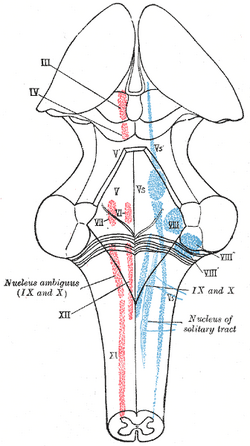Assessment |
Biopsychology |
Comparative |
Cognitive |
Developmental |
Language |
Individual differences |
Personality |
Philosophy |
Social |
Methods |
Statistics |
Clinical |
Educational |
Industrial |
Professional items |
World psychology |
Biological: Behavioural genetics · Evolutionary psychology · Neuroanatomy · Neurochemistry · Neuroendocrinology · Neuroscience · Psychoneuroimmunology · Physiological Psychology · Psychopharmacology (Index, Outline)
| Brain: Abducens nucleus | ||
|---|---|---|
| The cranial nerve nuclei schematically represented; dorsal view. Motor nuclei in red; sensory in blue. The olfactory and optic centers are not represented. (Abducens nucleus is VI) | ||
| [[Image:|250px|center|]] | ||
| Latin | ' | |
| Gray's | subject #187 787 | |
| Part of | ||
| Components | ||
| Artery | ||
| Vein | ||
| BrainInfo/UW | hier-580 | |
| MeSH | [1] | |
The abducens nucleus is the originating nucleus from which the abducens nerve emerges - a cranial nerve nucleus. This nucleus is located beneath the fourth ventricle in the caudal portion of the pons, medial to the sulcus limitans. The abducens nucleus along with the internal genu of the facial nerve make up the facial colliculus, a hump at the caudal end of the medial eminence on the dorsal aspect of the pons.
Damage to the abducens nucleus causes monocular medial ophthalmoparesis: specifically, loss of the ability to move the ipsilateral eye outward (abduction). This is also seen in damage of the abducens nerve. In contrast, damage to the area of the nucleus can also result in lateral gaze paralysis: loss of the ability to move both eyes conjugately away from the side of the lesion. This is due to damage to both the motoneurons and interneurons projecting through the medial longitudinal fasciculus to the contralateral medial rectus neurons.
See also
References & Bibliography
Key texts
Books
Papers
Additional material
Books
Papers
External links
- Description at University of Wisconsin
- Loyola
- Template (look for "GSE")
- BrainMaps at UCDavis Abducens%20nucleus
| This page uses Creative Commons Licensed content from Wikipedia (view authors). |
